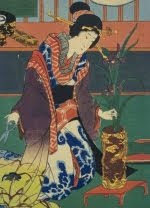I had the opportunity to attend a class at the Sogetsu Headquarters earlier this week. It was great to experience the atmosphere and see the building that I've read so much about. Amongst many other things there is a large selection of interesting ikebana containers to choose between. It was especially nice since I recognized many of them from photos of Sogetsu arrangements.
The class was taught by Koka Fukushima, one of the master teachers at the headquarter. Since I'm not that used to Japanese plant materials I got to work with to kinds of typical Japanese branches, finding a way to arrange them that shows the character of both the materials. I had jet lag and was kind of stressed by the whole situation and wasn't that satisfied with the result of my work. At first it was really out of balance, but with a little help and advice I think it turned out acceptable. Sometimes you just have to accept that you did your best under the circumstances, and anyway it was a great experience.




.jpg)





















